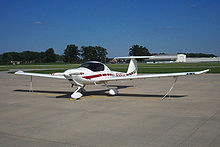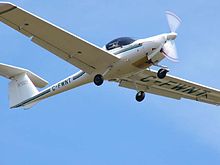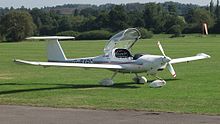- Diamond DA20
-
DA20 Flying Colors Precision Flight Team (DA20-A1-K100 Katana) Role Flight training and personal use aircraft Manufacturer Diamond Aircraft Introduction 1992 Produced 1992-present Unit cost $184,980 (2009 base price)[1] Developed from Diamond HK36 Super Dimona Developed into Diamond DA40 The Diamond DA20 is a two-seat tricycle gear general aviation aircraft designed for flight training. In addition to its role as a civil and military training aircraft, it is also used for personal flying by pilot-owners.[2]
Contents
Development
The first DA20 was the Rotax 912 powered A1 Katana produced in Canada in 1994. It was the first Diamond aircraft available for sale in North America. Production of the Continental IO-240-B3B powered C1 Evolution and Eclipse models began in 1998, also in Canada. Production of the A1 Katana is complete but the DA20-C1 is still being constructed in 2010.[3]
The DA20-A1 and C1 are both certificated under CAR 523[4] in Canada and under FAR 23 in the USA. The DA20 is certified in the utility category, and it is permissible to intentionally spin it with flaps in the full up position.[5] In 2004, Diamond received Chinese certification for the DA20. Both models also hold JAA certification.[6]
Although the DA20 is available with instrumentation and avionics suitable for flight under instrument flight rules (IFR), its plastic airframe lacks lightning protection and thus does not qualify for IFR certification.[2]
Design
The DA20 features control sticks (as opposed to yokes), composite construction, a canopy, low-mounted wings, a single fuel tank, a T-tail, and a castering nosewheel. All models have composite airframes constructed of glass- and carbon-fiber reinforced plastic.[2] The nose wheel of the DA20 is not linked to the rudder pedals and turns while taxiing are made with differential braking, with rudder steering becoming more effective as airspeed increases.[7]
The DA20 is equipped with a bubble canopy. Small windows on either side of the canopy can be opened on the ground and in flight to provide cockpit ventilation. This canopy design, however, lets in an above-average amount of sunlight into the cockpit, increasing the cockpit's initial temperature. The DA20's seats are reclined and are not adjustable, instead the rudder pedals are adjustable fore and aft to accommodate pilots of different height. The fixed seats provide better occupant crash protection. The seats in the C1 variant have a less obtuse angle, but, like the A1, are not adjustable. Both models are available with cloth or leather seat coverings.[2]
The DA-20 possesses a higher glide ratio than many of its competitors. The glide ratio of the DA20-C1 is 11:1 and the DA20-A1 is 14:1.[8]
In November 2008 the company announced that it would be offering an Aspen Avionics glass cockpit primary flight display as an option on the DA20. Diamond indicated the Aspen PFD was easy to incorporate into the existing instrument panel design because it mounts in a standard round instrument hole. In October 2009 the company introduced the Garmin G500 glass cockpit as an option.[9]
Operational history
USAF
Embry-Riddle Aeronautical University provided the Academy Flight Screening (AFS) program for the United States Air Force Academy in DA20-C1 "Falcons", which were specially ordered with slightly smaller fuel tanks to save weight and primary flight instruments on the right side of the aircraft. Embry-Riddle operated a fleet of DA-20s at the Academy.[10] The AFS program was discontinued in 2007.
Doss Aviation, under contract for the US Air Force, currently operates a fleet of DA-20s at the Pueblo Memorial Airport in the Initial Flight Screening (IFS) program.[11]
Variants
- DV20 A-1 "Katana"
- A development of the Diamond HK36 Super Dimona motorglider, powered by a 80 hp (60 kW) Rotax 912 and certified in 1993[12]
- DA20 A-1 "Katana"
- Developed from the DV20. Powered by a 80 hp (60 kW) Rotax 912 and introduced in 1995[12]
- DA20-100 "Katana 100"
- Factory refurbished and re-engined Katana for the European market. Powered by a 100 hp (75 kW) Rotax 912S. Introduced in 1999.[12]
- DA20 C-1 "Katana" and "Katana Eclipse"
- Name used in marketing and some 1998 year model planes. The name "Katana" was actually painted on some planes. Powered by a 125 hp (93 kW) Continental IO-240 engine. In order to accommodate the extra 70 pounds of the IO-240, the Katana's battery was moved behind the baggage bay, to help move the empty cg aft, and the wing sweep has been changed from 1 degree aft to just 0.5 degrees back to shift the center of lift forward. Previous Katanas had simple hinged flaps — but at the higher maximum weight, more sophisticated slotted flaps were necessary to bring the stall speed to the JAR-VLA-specified 45 knots[13]
- DA20 C-1 "Evolution"
- Stripped down C-1, intended for flight schools as a trainer. No rear windows. Powered by a 125 hp (93 kW) Continental IO-240-B engine[12][13]
- DA20 C-1 "Eclipse"
- Better equipped C-1 for private use, with rear windows for better visibility. Powered by a 125 hp (93 kW) Continental IO-240-B engine Entered production in 1999.[12][13]
- DA20 C-1 "Falcon"
- Military trainer version. Powered by a 125 hp (93 kW) Continental IO-240-B engine. Instruments moved in front of the right seat, where the student sits. This puts the stick in the student's right hand and throttle in the left, similar to fighter aircraft. Also equipped with a smaller fuel tank. Some Embry-Riddle Falcons have been sold to private owners and flight schools after being fitted with standard instrument panels and fuel tanks.[13]
Specifications (DA20-C1)
Data from DA20 webpage[14]
General characteristics
- Crew: one, pilot
- Capacity: one passenger
- Length: 7.16 m (23 ft 6 in)
- Wingspan: 10.87 m (35 ft 8 in)
- Height: 2.18 m (7 ft 2 in)
- Wing area: 11.61 m² (125 ft²)
- Empty weight: 529 kg (1,166 lb)
- Useful load: 271 kg in the USA and Canada; 221 kg elsewhere (597 lb / 487 lb)
- Max takeoff weight: 800 kg in the USA and Canada; 750 kg elsewhere (1,764 lb / 1,653 lb)
- Powerplant: 1 × Continental IO-240-B Fixed pitch Hoffman, Sensenich, 93 kW (125 hp)
Performance
- Never exceed speed: 164 knots (304 km/h, 189 mph)
- Cruise speed: 138 knots (256 km/h, 159 mph) @ 5.5 gal/hr
- Stall speed: 42 knots (CAS) (78 km/h)
- Range: 1013 km (547 nm, 623 mi)
- Service ceiling: 4,000 m (13,120 ft)
- Rate of climb: 5.08 m/s (1,000 ft/min)
- Wing loading: 64.6 kg/m² (13.2 lb/ft²)
- Power/mass: 124 W/kg (0.0756 hp/lb)
See also
- Related lists
References
- ^ Diamond Aircraft (undated). "Diamond DA20C1". http://www.diamondaircraft.com/build/index.php?id=20. Retrieved 2009-09-17.
- ^ a b c d Diamond Aircraft (undated). "DA20-C1 Multi-mission Machine". http://www.diamondaircraft.com/. Retrieved 2008-05-04.
- ^ Diamond Aircraft website
- ^ Transport Canada NICO website accessed 15 September 2007
- ^ "Operating Limitations". DA 20 Flight Information Manual (DA202/11 FIM). 1997-02-12. pp. 2–7.
- ^ Diamond Aircraft (December 2004). "Beijing PanAm starts commercial flight training with all glass DA40 Diamond Stars". http://www.diamondaircraft.com/news/news-article.php?id=84&search=. Retrieved 3 October 2010.
- ^ "Normal Operating Procedures". DA 20-A1 Flight Information Manual (DA202/11 FIM). 1997-02-12. pp. 4–13.
- ^ "Emergency Procedures". DA 20-A1 Flight Information Manual (DA202/11 FIM). 1997-02-12. pp. 3–13.
- ^ Niles, Russ (November 2008). "DA20 With Aspen Glass". http://www.avweb.com/news/aopa/AOPAExpo2008_DA20WithAspenGlass_199156-1.html. Retrieved 2008-11-08.
- ^ "Embry-Riddle Wins Contract to Train Air Force Pilots". http://www.erau.edu/er/newsmedia/newsreleases/2002/airforce.html. Retrieved 2008-012-16.
- ^ "Doss Initital Flight Screening (Aircraft)". http://www.dossifs.com/index.php?option=com_content&view=article&id=64&Itemid=83. Retrieved 16 October 2010.
- ^ a b c d e Diamond Aircraft (2009). "DIAMOND AIRCRAFT. A History...". http://www.diamondaircraft.com/why/index.php?id=1. Retrieved 2009-04-14.
- ^ a b c d Marsh, Alton K. (undated). "Diamond Eclipse - Delivery for the Air Force". Archived from the original on 2008-06-21. http://web.archive.org/web/20080621062759/http://flighttraining.aopa.org/learntofly/articles/diamond0308.cfm. Retrieved 2009-04-14.
- ^ "Diamond Aircraft DA20 webpage". http://www.diamondaircraft.com. Retrieved 2006-12-23.
External links
- Diamond Aircraft Industries
- Katana Review by Philip Greenspun
- DA-20-A1 Katana Flight Manual
- DA20-C1 Eclipse Flight Manual
Diamond Aircraft Industries DV20 Katana · DA20 Katana/Evolution/Eclipse · DA36 E-Star · DA40 Diamond Star · DA42 Twin Star · DA50 Super Star · D-Jet · HK36 Super Dimona
Lists relating to aviation General Aircraft (manufacturers) · Aircraft engines (manufacturers) · Airlines (defunct) · Airports · Civil authorities · Museums · Registration prefixes · Rotorcraft (manufacturers) · TimelineMilitary Accidents/incidents Records Categories:- Austrian civil trainer aircraft 1990–1999
- Austrian civil utility aircraft 1990–1999
- Canadian civil trainer aircraft 1990–1999
- Canadian civil utility aircraft 1990–1999
- Diamond aircraft
- Vehicles with Wankel engines
Wikimedia Foundation. 2010.






